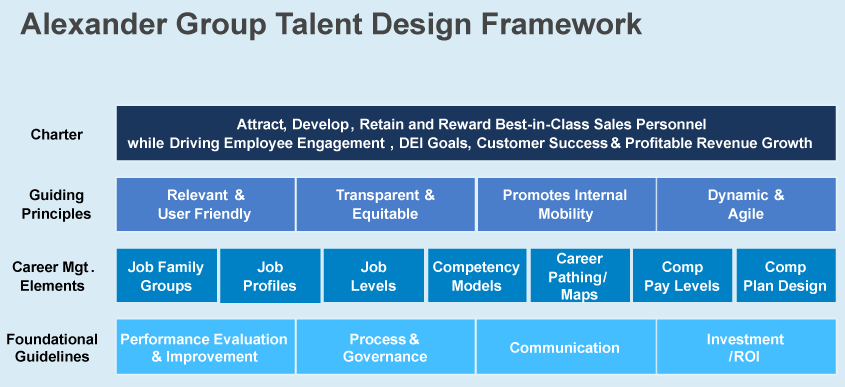Right Sizing Organizations

How to Evaluate Talent and Optimize Team Retention
Whether divesting lines of business, exiting geographies or rationalizing headcount, prepared leaders need a well-defined toolkit to effectively assess which assets in their organization are critical to future success and which are expendable. The challenge is that ‘people assets’ are so multi-faceted that most business leaders lack insights into where to focus. People don’t fit into a discounted cash flow (DCF) or multiples analysis and cutting in the wrong places can increase drag in returning to profitable growth.
Layoffs happen. No leader is excited to ‘right size’ their organization. At the end of the day, these were team members that helped build the business to where it stands today. However, staff reductions are a natural component of economic cycles. Alexander Group’s 2023 Media & Consumer Trends Research highlights “right-sizing organization” as the #1 focus area for driving profitable growth. Market leaders recognize the opportunity cost of not aggressively hiring in periods of growth is too significant to eliminate the possibility of future downsizing.
Past Performance Is No Guarantee of Future Results
Consider this scenario: headcount targets for the upcoming year are set and there is debate about which individuals earn the final two spots on the roster. There are three incumbents in the discussion:
- Candidate #1 is a longstanding strong performer. They hit their targets every year, contribute to company culture, develop people around them and receive positive customer feedback.
- Candidate #2 had their best sales year yet. They are hitting their stride but operate in a silo. They reluctantly accept feedback, often miss internal deadlines and make limited contributions to company culture and those around them.
- Candidate #3 narrowly missed their target for the 2nd year in a row. They follow company processes and proactively manage the pipeline. They support peers and receive positive marks from customers.
Candidate #1 clearly secures one spot, but how heavily do we weigh recent metric performance vs. organizational buy-in for that last opening? This is where a talent competency model can clarify the unique skillsets that each individual possesses and their growth potential in the organization.
What is a Talent Competency Model?
A competency model is an integral element of an organization’s overarching talent management framework. As illustrated in Exhibit A below, effective talent management links the roles required to deliver an exceptional customer experience, job leveling to create meaningful career paths and competitive pay to retain star performers. The invisible thread that ties these three components together is a competency model that codifies core attributes for each role and the varying levels individual effectively operate and develop.
Exhibit A: Talent Management Framework

Consider a sales-focused competency model where attributes may span across sales execution, relationship management, technical acumen, etc. The nested skill levels codify how adept individuals are at executing within those attributes. Does this mean individuals need to possess all attributes? No! The value of a competency model is in aligning which roles need to be proficient in which areas to effectively serve customers as a collective team.
Establish Transparency and Growth Potential
The best competency models are built to grow with your team. Whether you have a build or buy talent strategy, a competency model helps outline the full range of skills needed in the organization and provides the throughline to career progression. As summarized by a recent performance marketing media executive, “This [competency model] was the most important and impactful thing we’ve done for our people in years!”
Yet building a competency model is not the end game. Once your competency model is developed, the next phase is to routinely evaluate your team to objectively consider promotions, evaluate training opportunities, identify emerging roles and understand where to save operating expense (OpEx). Alexander Group media and consumer technology clients report that competency models help to both de-risk talent attrition by providing meaningful and objective career pathways and reduced internal administration by rationalizing proliferating job levels.
Every customer-facing organization focuses on maximizing customer lifetime value, but when assessing your talent ecosystem, modern commercial leaders need a competency model to also maximize employee lifetime value.
Appendix A: Talent Archetypes
- The Top Performer: This employee consistently produces high-quality work, is knowledgeable and skilled in their field, and demonstrates a positive attitude and strong work ethic. They are an asset to the company and are often recognized for their exceptional performance.
- The Hard Worker: This employee may not necessarily be the top performer in terms of skills or knowledge, but they make up for it with their high level of effort and dedication to their work. They are willing to put in the extra hours and go above and beyond to get the job done.
- The Talented Troublemaker: This employee is a top performer who consistently achieves impressive results but may have a negative attitude or may be a poor culture fit. While their performance is strong, their attitude and behavior may negatively impact colleagues and company culture.
- The Expert: This employee is highly skilled and knowledgeable in their field, often considered the “go-to” person for specific tasks or projects. They may not always exhibit the highest level of effort or attitude, but their expertise and abilities make them a valuable asset to the company.
- The Problem Employee: This employee may have the skills and knowledge to do their job, but their negative attitude and lack of effort can be detrimental to the team and company as a whole. They may be resistant to feedback or change, and their behavior can create a toxic work environment.
- The Average Performer: This employee may not necessarily excel in any particular area, but they consistently meet expectations and contribute to the team in a positive way. They may not have the highest skillset or level of effort, but they are reliable and dependable.
- The Emerging Talent: This employee may be relatively new to the company or position, but they show a lot of potential and willingness to learn and grow. They may not yet have the skills or knowledge to excel, but they demonstrate a positive attitude and strong work ethic, and with proper training and guidance, they could become a valuable asset to the company.
- The Underperformer: This employee consistently falls short of expectations and may struggle with completing tasks on time or to the required standard. They may require additional training or support to improve their performance.
- The Jack-of-All-Trades: This employee has a wide range of skills and can perform well in multiple areas, making them a valuable asset to the team. However, they may not necessarily excel in any one area.
- The Negative Nancy: This employee always seems to have a negative attitude and may complain frequently or bring down the morale of the team. Their negative behavior can be contagious and detrimental to the overall workplace culture.
- The Innovator: This employee is constantly coming up with new ideas and ways to improve processes and procedures. They may not necessarily be the highest performer in terms of output, but their creativity and problem-solving skills make them a valuable asset to the company.
- The Company Lifer: This employee has been with the company for many years and has a deep understanding of the organization and its culture. They may not necessarily be the highest performer, but their loyalty and institutional knowledge make them an asset to the company.
- The Rising Star: This employee is a high performer with a positive attitude and strong work ethic and is poised to take on more responsibility and potentially move up within the company. They may require additional training or support to fully reach their potential.

Contact Us
For more information on talent management and competency models, contact a member of the Media & Consumer Technology practice.


